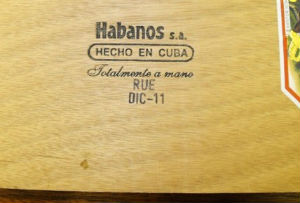Rupert Mackintosh brings out the inner train-spotter in you all, and talks about cigar box codes.

Few people would be surprised to learn that cigar boxes have important information printed on them; but life really does seem too short, doesn’t it? In much the same way Scrooge sees dollar signs before his eyes when handling money, many of us get a bit carried away when opening a fresh box of cigars and the packaging becomes, well, just that.
While worth remembering that Cognac, whisky and (to a certain extent) port do not improve “in the bottle”, cigars on the other hand do. To be clear, once cognac has left the oak barrel that it was stored in, the chemical bonding process stops, and it ceases to change profile and texture now that it is married to glass and not wood. Cigars however will continue to age and change (as long as they are stored correctly). Therefore, the production date of a cigar can be really important, as the code on the box will date the sticks inside and tell you how much age they have gained.
 There is also a less exciting but far more practical usage of the date code – avoiding cigars that are too young. Once they have been rolled, cigars tend to require about six months minimum to settle down and become less harsh and tannic. If you walk in to a major cigar retailer and ask for, say, a Montecristo No.2, that’s a pretty popular cigar. You will be given a stick that has been sat on the shelf for a week, flown over from Cuba last month, and rolled only two months before. Result? It tastes a bit harsh. However, if you picked up, say, a Sancho Panza ‘Sancho’, it would have been sat there for years (as few people want to smoke a 9 inch long monster stick from a brand few people have heard of!). Therefore, you can use the box code to establish if the cigar is too young (and best put down for a few more months) or has a nice bit of age (and thus a bargain – cigar prices go up with age, just like wine).
There is also a less exciting but far more practical usage of the date code – avoiding cigars that are too young. Once they have been rolled, cigars tend to require about six months minimum to settle down and become less harsh and tannic. If you walk in to a major cigar retailer and ask for, say, a Montecristo No.2, that’s a pretty popular cigar. You will be given a stick that has been sat on the shelf for a week, flown over from Cuba last month, and rolled only two months before. Result? It tastes a bit harsh. However, if you picked up, say, a Sancho Panza ‘Sancho’, it would have been sat there for years (as few people want to smoke a 9 inch long monster stick from a brand few people have heard of!). Therefore, you can use the box code to establish if the cigar is too young (and best put down for a few more months) or has a nice bit of age (and thus a bargain – cigar prices go up with age, just like wine).
I once smoked in a cigar shop (no names to protect the innocent) where they had a box of Punch Punch that were nearly ten years old. I happily worked my way through them, at usual retail price, when I would actually have paid a hefty premium for them! A little knowledge goes a long way.
So, here are the codes.
January / Enero - ENE
February / Febrero - FEB
March / Marzo - MAR
April / Abril - ABR
May / Mayo - MAY
June / Junio - JUN
August / Agosto - AGO
September / Septiembre - SEP
October / Octubre - OCT
November / Noviembre - NOV
December / Diciembre - DIC
These are all followed by a two digit date code (e.g. ‘13’ is of course ‘2013’).
Generally, try to aim for older cigars wherever possible, but don’t compromise on your usual quality requirements.
It’s worth bearing in mind that boxes with a *lot* of age can be from strange sources. Cigar shops are frequent big buyers at auctions. Lets say you lived to amass a great collection of cigars over the years (we’re talking hundreds of boxes in storage), then you passed away. These would probably be auctioned off, and a great chance to pick up some bargains from recent stock or some real vintage sticks no longer available. This is where the cigar shops come in, because they know the prices and can make a good profit. However, while they will always have good intentions, the fact the cigars have passed from person to person means, like a car, there isn’t a full service history any more. So do be careful if buying stocks from anyone but your most trusted merchants because the quality history on older cigars can be suspect. The late Colonel Sir Fippingham Smithely-Burke may have been a damn good chap at the Reform, but if he stored his cigars next to the toilet and sat on three boxes while blotto at the races, the cigars are best avoided! As with all things, buy with care!
For more on Cigars follow this link to Ruperts last article: what-leaves-make-up-a-cigar



















